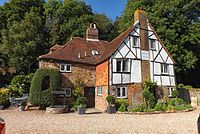Strand House, The Strand, Winchelsea
| Strand House, Workhouse | |
|---|---|
 |
|
| Former names | The Old Poor Houses |
| General information | |
| Type | timber frame Sussex Hall House |
| Architectural style | Tudor |
| Location | Winchelsea |
| Country | England |
| Coordinates | 50°55′33″N 0°42′48″E / 50.9257238°N 0.7132661°E |
| Completed | 1425 |
Strand House, The Strand, Winchelsea was the Parish Workhouse of the Sussex town of Winchelsea known as the "Old Poor Houses".
In the 13th century, old Winchelsea was one of England's most prosperous ports, particularly involved in the wine trade from Gascony but was lost to the sea. The new town of Winchelsea was laid out in 1283 in the form of a continental bastides town as a commercial centre for the importing of wine. The port was moved to the area of flat land, below the cliffs along the Strand. It was a river port, at the mouth of the River Brede which flowed out into a large lagoon, protected by a sandbar from the open waters of the Channel. The port connected with the town by a road that went up Strand Hill, through Strand Gate to the market place. The returning route went through the Landgate or Pipewell Gate, down Ferry Hill and into the port area.
Strand House was built just behind the port area at its eastern end at the foot of Strand Hill. It is thought to be located behind the Fish Market and re-used parts of stone walls from earlier store houses in the Quay area. A substantial farmhouse was built using the remains of these stone walls in 1425, probably by the church to farm the land in front of the house as the port declined and the sea retreated. A small second house, now known as "The Crow's Nest" stood behind Strand House and was constructed as a timber framed Sussex Hall house. If the house was owned by the church it is likely that it came into use as the town's workhouse after the town's decline in 1530 due to the silting up of the port and river. By 1565 the town was reduced to only 109 households when in the 14th century it had numbered in excess of 500 households.
The earliest known written record of Strand House is in a parliamentary report of 1777 which recorded a parish Workhouse in use at Rye with accommodation for 60 inmates; Brede with the capacity for 30; Iden that was able to house 20; and Winchelsea—St Thomas the Apostle with facilities for 24 inmates.
There is a collection of written correspondence relating to the workhouse in the Sussex Records Society archives dating from the early 19th century. An example is give below: "PAR 511/35/1/21 1 Sep 1823 Letter from William Watson, Rye to the overseers of Winchelsea John West (the bearer hereof) having informed me that he has made application to be appointed master of the poorhouse at Winchelsea and that it is necessary for him to produce testimonials of his good conduct, I beg to say that I believe him to be a sober, honest and civil man and very trustworthy. I have known his wife also many years and believe her to be a steady, honest, industrious woman".
...
Wikipedia
